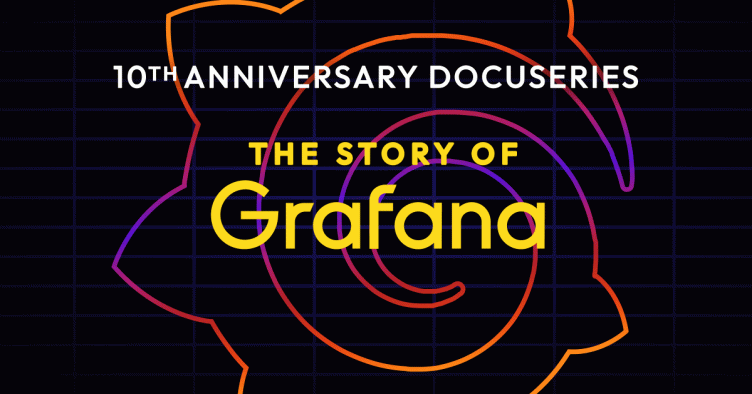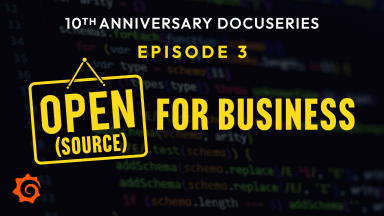
'The Story of Grafana' documentary: From one developer's dream to 20 million users worldwide
On Dec. 5, 2013, Torkel Ödegaard made the first commit in GitHub for a personal project that would become Grafana. “It’s hard to believe it’s been 10 years since Torkel launched Grafana, growing from a small man with a big dream to becoming the most popular data visualization software in the world,” says Grafana Labs co-founder and CEO Raj Dutt.
“The Story of Grafana” chronicles that meteoric journey. A year in the making, “The Story of Grafana” is a four-part documentary that dives into the origin story of Grafana and highlights the community behind the code, the growth of an open source business, and how Grafana has evolved over the years and continues to innovate.
Directed, produced, and edited by Grafana Labs Video Producer Collins Pace, the “Story of Grafana” documentary features more than 20 interviews, including Grafana Labs co-founders Ödegaard, Dutt, and Anthony Woods; early Grafana engineers, such as Carl Bergquist and Daniel Lee; and many voices from across the global open source community who have made contributions and continue to shape Grafana today.
Episode 1: Democratize metrics
The first episode reflects on the early days of Grafana, from Torkel’s initial 14-day commit streak in 2013 to the first-ever GrafanaCON in 2015. Grafana has since grown to become a thriving community with more than 20 million users worldwide.
When Ödegaard reflects on the past decade of dashboarding, “in some ways nothing has changed that much," he says. “I still wake up almost every day and work on Grafana — fixing bugs, looking at PRs, reviewing issues.”
But when you look at the scale of the project and the dynamic dashboards that have been created to do everything from monitoring NASA rocket launches to caring for a pet python, there’s no doubt that Grafana has become much more than a visualization tool.
As Grafana Labs Principal Engineer Carl Berquist puts it: “It was a cultural revolution.”
Episode 2: Community
In episode two, we explore the power of Grafana’s open source community and hear from early contributors who did everything from fixing spelling errors to building database support for OpenTSDB to inspiring our “big tent” philosophy, which promotes interoperability within a wider ecosystem.
“There have been a bunch of people in the community over the last 10 years who have been in the inner circle in many ways, even though they don’t work at Grafana Labs,” says Dutt. “I hope that they feel a sense of pride in what they’ve been a part of.”
Today, the Grafana community has more than 2,000 contributors from all over the world who are eager to open PRs, try new things, and yes, even break things together.
“What I see and I really enjoy is that the people who responded to me at the very beginning, they are still very active. They are still responding,” says Julien Pivotto, Principal Software Architect and co-founder of O11y. “Just seeing people stick to a project for so long is really something … That means there’s something more than just the code.”
Episode 3: Open (source) for business
At the first GrafanaCON in 2015, “there were so few people at the time who were customers, but everyone in that room was eager to help us, as a business,” Dutt says. “It was something that really made me appreciate the dynamic between the company and the community.”
That dynamic is the focus of “Open (source) for business,” the third episode in “The Story of Grafana” documentary series. With a wide range of perspectives, from Grafana Labs’ co-founders to employee no. 31 (hi, Peter Holmberg!), you’ll hear how Grafana Labs grew to become a successful open source company with more than 3,000 customers, including Bloomberg, Citigroup, Dell Technologies, Salesforce, and TomTom.
But the main mission of the company? To build a sustainable business around the open source Grafana project and then use the revenue from our commercial offerings to re-invest in the technology.
To that end, today 80% of Grafana Labs’ engineering resources go towards open source projects that we launched, and we contribute to other projects in the observability space, such as Prometheus and OpenTelemetry.
All of which aligns with one of our core strategies. “We don’t build technology for the buyer,” says Dutt. “We build technology for the practitioner.”
Episode 4: Evolution
In “Evolution,” the final episode of the docuseries, we explore how Grafana evolved into an integral part of the broader open source Grafana LGTM stack (Loki for logs, Grafana for visualization, Tempo for traces, and Mimir for metrics), which also powers the fully managed Grafana Cloud observability platform and the self-managed Grafana Enterprise offerings.
“That really was the beginning of Act II for the company: When Grafana became a lot more than just metrics — when we added logs, when we added traces, when it became a real observability solution,” says Grafana Labs CTO Tom Wilkie, who joined the company after his company Kausal was acquired by Grafana Labs in 2018.
In recent years, Grafana Cloud has also grown by allowing you to easily extend your observability stack to include tools such as Grafana IRM for incident management, Grafana Cloud Profiles for continuous profiling, and Grafana Cloud k6 for performance testing.
Says Grafana Labs Principal Engineer Carl Bergquist: “The product obviously evolved from targeting mostly open source enthusiasts to being more focused on the wider audience these days and an even richer plugin system so we can extend Grafana in ways we can’t imagine today.”



